2020 Mars Opposition Observations Part 2 (from 20 September)
June 2021
2021 June 16th
This will be the final blog post for this opposition. The tiny 4 arcsecond disk has still revealed considerable detail in the hands of S.Ito, A.S.Kidd and M.R.Lewis over the last few weeks. The most important aspect of the last few months’ observing has been the timing of the return of orographic clouds over the various martian volcanoes. The final image in my hands is by Kidd, dated June 13th, in which the Syrtis Major is just east of the CM. It is possible there may be a few more observations obtainable……
There is a note in the June BAA Journal about the Ingenuity helicopter (erratum: it weighs only 2 kg!), and a comparison with the first powered flight achieved in 1903 by the Wright brothers. A 3rd Interim report will appear in the August issue, and a final report in two parts is currently well advanced. Part I is essentially finished, and part II is nearly complete apart from the task of measuring all the images for the latitude of the SPC in order to compare its recession quantitatively with past years. With luck, I hope to submit the finished paper before the autumn.
And a final thought. At the seaside last Sunday, I was reminded that the substances of the sea and sand that give us such pleasure in our terrestrial vacations are the very same that produce phenomena to delight the telescopic observer of Mars, in his white clouds and dust storms: H2O and SiO2, respectively.
My thanks to everyone, and best wishes for a better summer as we finally emerge from the grip of this tiresome and prolonged pandemic. See you in 2022.
Observations are still being attempted by a few determined persons. The Director had a view of the tiny 4.5 arcsec disk on May 10 when Syrtis Major was near the CM and Hellas was lightish. Paul Maxson’s excellent sharp images show the NPC has considerably diminished in size. I would encourage all observers to try to secure a few more views. Until May 3 we had a long unbroken run.
An updated list of the 142 contributors has been attached. The Section report for 2018 has been submitted for publication, and the 2020 report is now far advanced.
May 2021
May 3
I have just written a summary of recent observations to appear in the June BAA Journal (or possibly in June and August, depending upon the space available), which also pays tribute to the Wright brothers’ flight of 1903 and the successful flights of NASA’s Mars helicopter.

Several contributors have continued to make useful observations in April. The NPC is obviously shrinking (as in this image by Mike Hood) and now has a well-defined S. edge that is convex to the south, while there are signs of white clouds but no evidence of dust storms. The long-enduring albedo change at Indus, linking Oxia Palus to Mare Acidalium, continues to exist. So too does Phasis. The tiny disk has made it nearly impossible for visual work to continue, but four observers were still making sketches in late April.
As of May 2 we had received 11,197 observations from 141 observers: a very fair total. And we have an unbroken observing run of 425 days……. perhaps not for much longer.
Yesterday I was able to submit the final 2018 Mars report (in the usual form of two papers) for publication.
April 2021
April 6
It is suprising how many observers have managed to continue, now that the martian disk is only 5″ in diameter. So I thank the following in the UK: Abel, Kidd, M.R.Lewis, McKim, Nuttall, Peach (with E.Enzmann) and Tickner, and the following overseas: Adachi, Aerts, Akutsu, Arakawa, Giuntoli, Konnai, Kurisu, Macsymowicz, Melillo, Ito and Warell.
P.Tickner’s image of March 25 compares how tiny Mars has become compared to how it looked at opposition.
There are still some points of interest. For instance, I noticed that S.Kurisu (Japan) in his image of March 23 had faintly imaged the historic form of Nepenthes, while the team of E.Enzmann (1m RC, near Munich) & D.A.Peach on March 31 achieved a similar result. Such halftones are much exaggerated in contrast when the phase is high, as it currently is, but I cannot recall such any suggestion of this marking as a BROAD feature during recent oppositions. Inde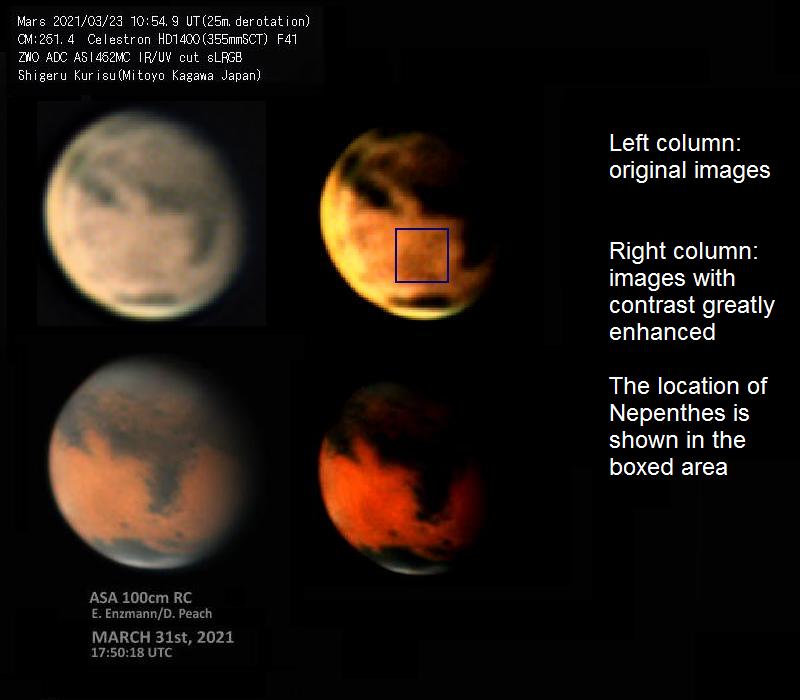 ed, Nepenthes was already faint when I began serious observations in the images in the mid-1970s: it had been prominent for much of the 20th Century. Its current shape much resembles, in a much
ed, Nepenthes was already faint when I began serious observations in the images in the mid-1970s: it had been prominent for much of the 20th Century. Its current shape much resembles, in a much
fainter form, its appearance in the photos of (say) 1958 or 1960 from Pic du Midi, Lick or Flagstaff. Will it reappear?
The value of De is becoming favourable for watching the NPC.
Yesterday we successfully completed an unbroken run of 400 days of Mars observation.
March 25
The long run of observations continues, and as of yesterday we have had a run of 388 consecutive days since 2020 March 2.
Confirmatory observations of the north polar cap and orographic clouds at the Tharsis Montes continue to be made. The NPH is now rarely reported and all observations show a narrow bright NPC. The southward value of De is decreasing rapidly now, bringing the cap more into view.
On Mar 23 and 24 from the UK, images were sent by M.R.Lewis that showed a belt of E-W white cloud over M.Acidalium (a feature which has persisted for some time), while both Basey and Lewis showed a wider southern band over Noachis-Argyre, though with darker features right on the S. limb. The albedo anomaly at Oxia Palus and SE Niliacus Lacus persists. Drawings were made by Abel, McKim and Nuttall. We were able to glimpse the morning mist caught by Lewis over Tempe, but the tiny disk (D=5.5 arcsec) is now becoming a real challenge for visual observers. From Japan on March 22 and 23, fine images by Einaga, Ito and drawings by Adachi show the belt of southern white cloud around CM 245 degrees, and evening cloud at Elysium. From the USA we have fewer contributors lately, but Maxson has been observing the Solis Lacus-M.Sirenum side lately, and his images show that southern clouds are also marked in those longitudes.
I hope we shall be able to carry on well into April.
March 2021
March 10
I am pleased to write that we have continued to be able to cover every single day, so that by March 1 we had an unbroken run of 365 days. The planet is now starting to show signs of equatorial cloud banding and of orographic clouds; this is seasonally normal. The latter have been imaged from the UK recently by Nick Haigh, and Japanese observers are also watching them. The NPC is bright at the limb but the hood is still sometimes in evidence.
The April Journal will contain part 2 of the 2014 report.
I am now busy with finishing off the 2018 final report on the global dust storm. Much of the labour has involved making daily collages and dealing with the fact that observers use different scales, orientations and processing. I cannot control the first and last but can I please appeal for images at least to have the areographic south pole precisely at the top, and not arranged in some fancy artistic way? This does not mean that the greatest phase defect will always be at 90 degrees to the poles. Please see the values of P and Q in the BAA Handbook, or a programme like WinJUPOS to help with orientation. Getting images the right way round saves a huge amount of my time.
Johan Warell has sent some excellent apparition maps which include polar projections. Has anyone else made polar projections, perhaps over a limited date range?
February 2021
February 20
On Feb 18 I watched the live commentary for the landing of the Perseverance Rover. Two hours earlier I had the satisfaction of a partially clear evening to watch the Sinus Sabaeus region at the eyepiece. That makes three successful missions by three different nations in a fortnight…. something of a record!
The decreasing northward tilt of the planet is bringing the NPC more into view. The NPH is still visible on the morning side at Mare Acidalium, and on Feb 10 and 12 respectively Paul Abel and Martin Lewis saw the hood separated from the cap by a dark horizontal line. Such phenomena have been seen in the past, of which the classic Dawes’ slit above Mare Acidalium itself is the best known example.
As the northern spring advances we shall see more white cloud appearing. Makoto Adachi on Feb 11 found the morning Syrtis Major looked bluish, showing there to have been morning cloud at the terminator. On the same date Simon Kidd caught a trace of morning cloud in Argyre, while on Feb 12 and 13 Tiziano Olivetti’s images show morning cloud in Hellas.
We now have 138 observers and the list posted at the top of the page is now updated with the recent addition of Paula Wirtanen (Finland). Other observers reading this should know that it is not too late to contribute further data.
The first observation received for this apparition was for 2019 October 28, and we achieved fair coverage for the first few months including 12 dates in December, 28 in January and 28 in February. Of much greater interest, however, is that we have received observations for EVERY SINGLE DAY from 2020 March 2 till today, 2021 February 20. This may be a record within the Section for an unbroken series, and I very much hope we can extend this record to a full year and more!
With most travel on Earth limited by the COVID-19 global pandemic, 2021 February was nevertheless a busy month for interplanetary travel, with three spacecraft scheduled to arrive at Mars. On Feb 9 the UAE Space Agency Hope Probe went into orbit, followed the very next day (today) by a spacecraft from China, Tianwen 1, while next week the NASA Perseverance craft, described in the 2020 October Journal, is expected to reach the red planet. The latter two missions comprise an orbiter, lander and rover. The UAE Mission involves insertion into a highly elliptical orbit which at closest approach usefully corresponds to a geostationary orbit and at its furthest facilitates whole-planet imaging.
Useful website resources in the English language are:
https://www.emiratesmarsmission.ae
https://en.wikipedia.org/wiki/Tianwen-1
https://mars.nasa.gov/mars2020/
These craft join a number of still active Mars missions.
The BAA final Mars report for 2014, part 1, has appeared in the February BAA Journal, and a pdf file will soon be posted on the front page. The concluding part will appear in the April issue.
None of the observations now being received show any sign of the SPC. A very high resolution image taken by Martin Lewis on Feb 3 showed many other tiny details but the SPC was certainly not present. The decreasing northerly tilt of the planet is now bringing the large NPC into view. The Director and Haigh made observations on Feb 9 when Argyre was light and the NPH was visible to lower latitude than the NPC in the longitudes following Acidalium. The Director had the same view this evening.
We may be able to see more seasonal white cloud activity soon, though the disk is now only 7 arcseconds in diameter. Please can I remind observers that even low resolution images are still very much appreciated?
A list of the 23 observers still active since 2021 mid-January is: Abel, Adachi, Aerts, Akutsu, Basey, Chappel, Einaga, Flanagan, Haigh, Hill, Hood, Ito, Konnai, Leatherbarrow, Lewis, McKim, Macsymowicz, Maxson, Melillo, Morales, Nuttall, Olivetti and Warell.
We have recently received some very interesting data from S.Neveu who, working with G.Dawidowicz has restored the 8.5-inch (22 cm) Calver reflecting telescope once owned by E.M.Antoniadi (Mars Section Director, 1896-1917), and has secured images with it to compare with the performance of the 25 cm OG of Juvisy observatory. They are writing a paper for the Bulletin of the French Astronomical Society, and we may have more details about their results in the BAA Journal later.
An excellent apparition map has now been prepared by T.Kumamori, and can be found at the OAA (CMO Japan) Mars website.
The Director was pleased to have been able to observe on the dates when the UAE and Chinese craft arrived at Mars, and to have obtained his 150th drawing of the present apparition on the latter date.
January 2021
2021 January 27
For this update I post an excellent albedo map – above – made by Martin Lewis. On this page the version without names, and on the front page a version with names.
2021 January 16
The best images continue to show the tiny SPC, though most of the ones now being received do not resolve it. The NPC is bright at the N. limb, but there is sometimes a sign of the polar hood too (extending to lower latitude) on the morning side. For example on Jan 12 Chris Nuttall shows the hood around the longitude of Mare Acidalium: this is typical of previous years. A similar effect at Utopia was recorded upon the images of Tiziano Olivetti for Jan 9. No dust activity is visible at the present time. It is important now to try and continue for as long as possible. (So far we have received data for every single day back to 2020 March 2nd, missing only five days in the whole of 2020.) We covered over 95% of the span of a martian year at the previous opposition, 2018. The metereological conditions at the Tharsis Montes, Elysium and the southern basins of Argyre and Hellas can always be recorded, even upon a shrinking disk.
2021 January 10
The late summer S. polar cap has been a most elusive object visually in 2021. A tiny dull cap is still clearly visible upon the very best images with apertures of 35 cm and above. Just north of the SPC, the belt of white antarctic cloud is less obvious, and on the latest images by Tiziano Olivetti it is actually brighter on the evening side.
A considerable brightening of the N. limb took place at the end of December, with a sharpening of its S. edge, showing that the polar hood had given way to the ground cap, but the tilt of the planet (De) has been so far to the south that we could not see the N. polar region properly. The writer rated the NPR as bright white on Dec 27 and VERY bright white on Dec 30, when it was thinner than on the 27th, and later. On the last date at x662 it was merely a narrow and very bright white strip along the N. limb. Until Dec 27 he saw the hood somewhat wider in blue light. Spacecraft images of early January clearly show a well-defined north polar cap with a sharp S. edge.
A short-lived belt of dust crossed Mare Acidalium according to images by Nick Haigh on Jan 3. There was no trace of it upon his next images on Jan 4. The Director had good seeing on Jan 5 and also saw no trace of it.
Another spacecraft is due to arrive at Mars soon. This is NASA’s Perseverance mission, which was described in my note in the 2020 October Journal. And our observations ought to continue for another couple of months at least.
I include a drawing from Jan 2 by Tom McCague (AZ, USA) and images on Jan 3-4 by Nick Haigh.
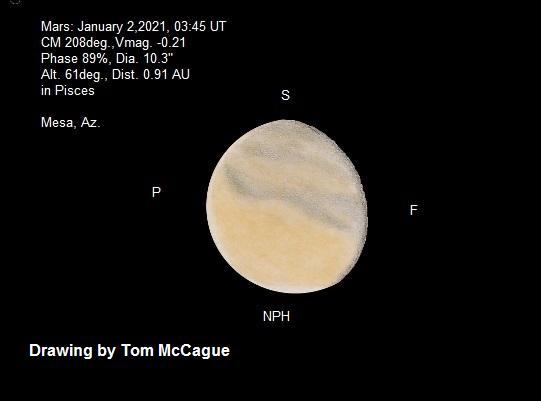
2021 January 1
In the past week the SPC has been sharp but progressively paler than previously. Visually it has always been a difficult object, but it was seen with certainty (for instance) by Abel, Nuttall and the Director from the UK, and by Adachi from Japan during Dec 27 to 30. Images over the same period (e.g., by Maxson and Melillo in the USA, and by Ito and Kumamori in Japan) also continue to show the SPC distinctly, but as in the visual work, the band of white cloud to its immediate north (which is brighter at the terminator) seems to have become wider, reaching nearly to the edge of the cap.
On the morning of Dec 31 images by Go, Kumamori and Maxson show the cap especially dull, and at the limit of visibility, while Adachi no longer saw it visually. Observing on the evening of the same day I could no longer be sure of its existence, although the area was very light.
The coverage of the cap by the polar hood is therefore imminent. Later, we should be able to time the reappearance of the N. polar cap. The NPH is brighter and – due to foreshortening on account of the currently high positive value of De – thinner.
The next two issues of the BAA Journal will contain the final two-part Mars report for 2014, which was accepted for publication three years ago, and which has waited for space till now. A similar report on 2016 is also in the queue. The final report for 2018 is far advanced. Another interim report on the current opposition will probably appear in the February or April issue.
Do please keep observing Mars: the small disk presents us with fewer details, but important meteorological data can still be acquired.
I wish everyone good luck in 2021. We certainly need it.
December 2020
2020 December 21
Observations from around the world continue to show a tiny SPC and what looks to be a continuous belt of antarctic cloud to its north. The latter is bright in blue light and very bright in UV, as P.W.Maxson shows on Dec 20 (posted here). A similar belt of cloud was seen in the last opposition just prior to the appearance of the hood over the S. polar region.
During the 2016-17 apparition we could follow the summer cap till Ls = 333, which was not late enough to see the commencment of the polar hood.
During 2018-19 our observations continued late enough to watch the details of the transition, during 2019 February. From a preliminary analysis, the polar hood appeared during Ls = 338-339.
On Dec 20 we had already reached Ls = 334. These seasonal events show slight interannual variations, due presumably to the variable degree of atmospheric dust-loading. Good observational coverage is now needed.
December 18
Upon images from around Dec 3 onwards (M.Hood, P.W.Maxson, G.Walker, etc.), a light belt of white cloud can be seen to run E-W from the evening Argyre across the south of Thaumasia to the morning terminator. On Dec 5 at 02:38 (CM = 098) to 02:53UT, Maxson’s UV image showed the cloud belt wider and extremely bright at the morning terminator. In the following days the cloud belt was seen at other longitudes, for example to Foster on Dec 9 under CM = 284, and partly to the Director on Dec 14 under CM = 210 and again last night. It was less prominent in white light, but a blue filter made the cloud brighter and more certain, and longer east-west. The cloud is again shown on Dec 15 by D.R.Basey, whose colour and blue filter images are posted here. It seems the cloud extends around the planet.
This cloud could not have been present during the regional storm, owing to the warming effect dust has upon the atmosphere. But soon it will be the time to watch for S. polar clouds and the polar hood. We want to time the disappearance of the cap beneath the hood, and the first appearance of the north polar cap around (and probably just before) Ls = 0. Can I therefore urge observers not to give up yet, and continue as far into 2021 as they possibly can?
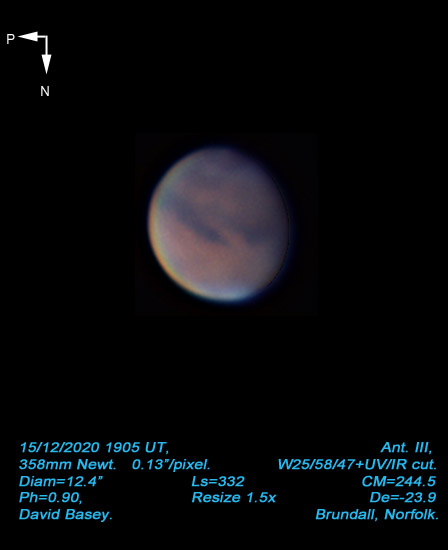
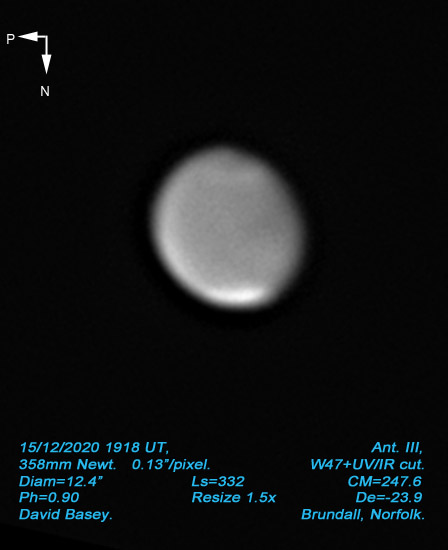
December 6
Shrinking diameter, bad UK weather and the cessation of the large regional dust storm have all contrived to reduce the number of observations being made.
I am now posting the promised collage to illustrate the dust storm observed visually by myself from the UK. I did not yet have time to colour these drawings, but I took notes at the eyepiece so that it can be done later if required. Increasingly bright areas – most of these located outside the latitude of the north polar hood – are denoted +, ++ and +++. Antoniadi used to use exclamation marks for such areas. And I have added a capital Y to denote the more obvious yellow dust clouds. Descriptions of the storm on these dates have already been given; suffice to add that on Dec 5 the storm was over and contrasts normal, except that the SPC was whitish but not bright. The dust in Hellas was clearly settled and not as bright as earlier.
An interesting set of images by C.Pellier for Nov 22 has come to hand in the last few days, in which he draws attention to the bright morning cloud visible in blue-violet and ultraviolet light. I notice that it was bordered by an anomalous dark area, which obviously cannot be a shadow but which seems to be what we have in the past called a ‘Violet Hole’, where the local water vapour concentration is very low, so that the ground appears darker. Similar images were taken on the same night by M.Delcroix.
By November 7, 120 observers had submitted 5,354 images and 665 drawings. By December 6, after another exhaustive count, I found that we had then received 7,049 images and 981 drawings, and that we have acquired another ten active observers.
December 2: The Regional dust storm
Nov 27-28:
The E. end of the ongoing Regional storm in Ausonia looks very much like the previous day, except that the Hellas dust seems to be further weakening: compare the three images by Kumamori (Japan) at virtually the same CML, during Nov 26-28, posted here. There are no changeable bright patches remaining within the area previously covered by the storm, so the event seems to have finished.
Nov 29:
Today’s image by Foster (and those taken on the 27th and 28th) show that the albedo anomaly at Margaritifer Sinus-Oxia Palus-Indus remains.
Nov 30:
After three consecutive cloudy nights from my observatory in Northamptonshire, I was able to observe visually near CM = 023 and to verify that visual contrasts were nearly normal. Hellas was bright yellow, but doubtless the dust there – static – is now settled, while Noachis and Argyre contained rather dull creamy-yellow areas, also static, which must also be dust fallout. There were no specific bright dust clouds. The northern deserts looked to me to have the usual washed-out orange tint.
I thought the SPC was a little less bright than on Nov 26. This was also the impression of Chris Go, Bill Leatherbarrow and Manolo Rodriguez on the same date. We know that some dust migrated to high southern latitudes, so a small amount over the pole is not really unexpected. (Last night, on Dec 1, Paul Abel and I had the same impression.)
I shall soon post a collage of my own drawings showing the decline of the west end and central region of the storm over several days, and I cannot recall having been able to observe Mars on 15 out of a possible 30 nights in November. Not a bad record for the UK.
The list of observers – there are now 130! – is hereby updated.
Future updates will now be less frequent, unless there is another significant development.
November 2020
November 27
Nov 26:
The regional storm has definitely finished in its central and western portions, but the extreme eastern end is still active and changing. Images of the 25th showed some dust spilling over the eastern edge into Ausonia, and today’s observations confirm this and suggest that dust has moved northwards within Ausonia. This is quite typical behaviour. The other hemisphere remains clear of any activity. By observing very early in the evening from the UK it was possible to watch nearly all of the storm. I recorded my impressions for Nov 26 in yesterday’s posting, but had not received any images showing that side of the storm as I come to post this note today.
November 26: Regional storm news
Nov 25
A daily collage is again posted here, which shows dust still occupying Hellas as far south as Zea Lacus: see the excellent images by MacNeill and Lonsdale. Lonsdale, who observed earlier, shows that activity has slightly spilled over the eastern edge of Hellas into Ausonia, and there is confirmation of this in the other images received. The yellowness of the new little patch there shows its nature. There is no longer any atmospheric dust over Deucalionis Regio, while the other parts of the storm are now weakening, and we are starting to see albedo markings resume their normal intensities. The Director was able to observe around 17.00UT and could already see the faded W. end of Sinus Meridiani as well as the partially veiled Sinus Margaritifer at the evening limb. The limb was mostly bright yellow, and other specific light dusty areas on the eastern side of the disk were less apparent than two days earlier. Much of Mare Erythraeum looked dark. The Valles Marineris dust was still present but faint, and had surely settled out upon the ground. These eyepiece impressions were borne out by the images of Fattinnanzi posted here, and by those of several other observers in France and Spain posted at the ALPO Japan website.
Nov 26
Tonight I was able to make my 100th drawing of the 2020 apparition. The Hellas dust was seen at the p. limb, but elsewhere one had the impression of a generally decaying event with contrasts returning more nearly to normal. I intend to post illustrations tomorrow.
Nov 26 this year is Thanksgiving Day in the USA, and it reminds me of an occasion in 1988 when our American friends were able to discover what became a large Regional dust storm on that very day. The ALPO christened it the Thanksgiving dust storm. The BAA report for that year – downloadable from this website – gives a full discussion of the event, photographs, drawings and a map showing its progress.
November 25: The Regional dust storm
Nov 23:
I have added two images of the centre and west end of the storm to the collage that was posted yesterday. Those by D.Kolovos (Greece) and A.Cidadao (Portugal) had not previously been available. I have also added one of my own drawings, which I have not yet had time to render in colour.
Nov 24:
The dust in the NW of Hellas is now covering the NE corner as well, but shows little sign of spreading south of the albedo feature Zea Lacus, which is located in the basin’s centre. The Hellas dust is spilling over the west edge of the basin, hiding Hellespontus, and merging with the existing dust in Deucalionis Regio which has faded to near invisibility. The whole of Meridiani Sinus has weakly reappeared, following the clearing trend noted yesterday. The western side of the event continues to decline. I have made a daily collage and am posting it here.
Nov 25:
I have again watched the dust storm tonight but under less favourable seeing conditions: these are now becoming more obtrusive as the disk shrinks to under 16 arcsec. When I have sufficient other observations to hand I will include them in tomorrow’s post.
Finally I have made a further collage summarising different aspects of the planet during Aug-Nov, arranged in order of increasing CM longitude, due to the efforts of L.Morrone (France), M.Foulkes (UK), P.Tickner (UK), M.Delcroix (France), T.V.Haymes (UK), R.Bosman (Netherlands), M.Barbieri (Italy), A.R.Pratt (UK) and P.Casquinha (Portugal).
November 24: The Regional dust storm
Nov 22:
On its eastern side, the dust storm is now encroaching upon Hellas, the activity at E. Deucalionis Regio having now invaded Yaonis Regio, with Yaonis Fretum marking the eastern edge of the activity. The individual bright dust cores within Deucalionis are more smeared out. The brightness of the dust at Valles Marineris looks reduced, but the dust core at Thymiamata veiling Meridiani Sinus and Margaritifer Sinus is still quite bright. Sinus Sabaeus is broken through at Edom where further small dust clouds are seen. Dust covers Argyre and much of Noachis, with anomalous darkenings of the deserts immediately to their southand east.(When this storm settles I think Hellespontus-Mare Serpentis will be broad and dark, as on previous occasions.) The Argyre dust core cuts through Phrixi Regio/Bosporos towards Thaumasia but then virtually ceases, apart from a small faint patch of dust south of Solis Lacus. Contrasts around Solis Lacus, Aurorae Sinus and western Erythraeum are again nearly normal. The SPC is unaffected, as is the NPH.
A daily collage is given here. The one-shot colour image by Lewis shows the western end of the dust better than one compiled from IR, B and synthetic green images. The image by Eric Sussenbach (taken from the island of Curacao) shows that the Mare Sirenum side of Mars is unaffected.
Nov 23:
On the eastern front, dust is now actively invading the northern half of western Hellas, having crossed and blotted out Yaonis Fretum. The dust that had earlier developed at eastern Deucalionis has faded: it seems as though the activity there had simply moved east into Hellas. The eastern ‘prong’ of Sinus Sabaeus is recovering its darkness. The Thymiamata bright cores have diffused away, and Margaritifer Sinus is again weakly visible. The Valles marineris dust is weakened, so the central portion of the storm is dying out. But the storm is also dying out on the west: the dusty region covering Argyre is less bright, and dust is no longer seen to the south of Solis Lacus. The Director at 1650UT (CM = 58) found many albedo markings still effaced by a complex system of bright yellow clouds to the east of the CM, but the planet was almost normal to the west.
Another daily collage summarises the situation.
Later I intend to post a series of my own drawings.
November 23: The Regional dust storm
Nov 21:
The eastern part of the storm on Nov 21 is portrayed by C.Go and T.Kumamori. Makoto Adachi has posted a series of no fewer than seven of his own excellent drawings posted at the website of ALPO Japan. The western end of the storm is shown here in two fine natural images by M.Rodriguez (Spain). See the collage. The limits of the storm were already described in yesterday’s post. Notice how the dust in Deucalionis Regio cuts north across Sinus Sabaeus at the longitude of Edom, though most of Sabaeus is unaffected. Meridiani Sinus is still faint.
Nov 22:
The general impression since Nov 21 is of little change in the east, but a continuing slight decay in the west. The Director had good seeing near 1700UT with Aurorae Sinus at the CM. While a complex pattern of bright dust remained at Noachis-Argyre, Mare Erythraeum and Valles Marineris, the lane of dust S. or Sp. Solis Lacus had nearly faded out. He saw Erythraeum mottled by a complex sheet of dust clouds. The SPC and NPH were unaffected.
Nov 23:
Again observing around 1700UT the Director could watch the area from Thymiamata to Solis Lacus. The western end of the storm has surely decayed, but bright yellow dust clouds covered the p. limb. Margaritifer Sinus was mostly obscured but Mare Erythraeum was recovering its intensity towards the west.
I will post images and drawings for Nov 22 and 23, and more details of other observers’ work on the 23rd, later.
November 22: The Regional dust storm
Nov 21: The storm continues to affect longitudes from Hellespontus on the east to nearly Aonius Sinus on the west. The new dust cores observed on Nov 20 at eastern Deucalionis Regio were still active today, and Meridiani Sinus remained obscured, but Sinus Sabaeus still looked nearly normal, and no dust had yet invaded Hellas. The existing dust core at Thymiamata (Aram) remained bright, with dust hiding much of Margaritifer Sinus. The Valles Marineris and Noachis-Argyre dusty areas appeared much as on the 20th. Some areas near the pole are now exhibiting anomalous darkening due to dust being excavated from them and then moving away: this is a well-known phenomenon that can be traced back to photographs of the encircling storm of 1956 when Hellesponticae Depressiones was similarly darkened. The SPC remains unaffected.
The western end of the storm is definitely fading, and the belt of dust stretching across Phrixi Regio/Bosporos south of Solis Lacus was still fainter today, but nonetheless visible upon drawings by Nuttall and the Director and in images posted online. (See in particular the nice images by Manolo Rodrigeuz from Seville, Spain, at the ALPO Japan website.) Observing around 17.00 UT with Solis Lacus near the CM, the Director found extensive bright yellow dust clouds upon the evening limb stretching from mid-northern to high southern latitudes. These were particularly strong over Noachis-Argyre and in the latitude of Mare Erythraeum. Dust along part of Valles Marineris was also seen towards the limb. But the NPH remained rather well visible, and was seen to be eccentrically placed with respect to the pole.
Later the Director will post a series of his own sketches to show the decline of the W. end of the storm, including an observation from Nov 22 which I have just made, and images taken by various observers. Posting a daily update to this blog is a difficult task!
November 21: regional storm update
Nov 20:
Today the ongoing dust storm at Thymiamata (aka ‘Aram’ on the Ebisawa map) – which lies between Meridiani Sinus and Margaritifer Sinus – has expanded to cover Meridiani, though Sinus Sabaeus is still largely unaffected. Simultaneously there has arisen a new cluster of small bright dust cores in E. Deucalionis Regio, which effectively mark the eastern limit of this increasingly complex Regional event. I cannot recall ground-based work ever having resolved individual dust cores within this area before. Without measuring it, it looks to be located a fraction north of where the initial cloud of the 1956 Encircling storm began: see page 73 of the BAA dust storm Memoir for those readers who possess a copy. Comparing the images by Go for Nov 19 and 20 shows little or no change in the dust running from S. Hellespontus diagonally across Noachis and Argyre. Furthermore the western end of the event now seems to be fainter and rather static, according to the latest UK and European data. The dust at Valles Marineris is less bright than the new dust cores at Thymiamata and Deucalionis, and I suspect it is settling. If so, it will fade further with time.
UK observers – if they can start early enough in the evening – will be able to see the western half of the event. Our Far Eastern observers are now losing this region at the morning terminator, but can access the developing eastern part. This fact emphasises the need for an international effort in order to continue to follow the event.
I am posting some comparative images during Nov 13-18 by Ross Osborne (Australia), an image by Luke Gulliver (Australia) for Nov 18, images for Nov 19 and 20 by C.Go (Philippines) and for Nov 20 by A.Wesley (Australia). Wesley’s brightened copy image indicates the presence of a terminator projection: there have been other such observations lately.

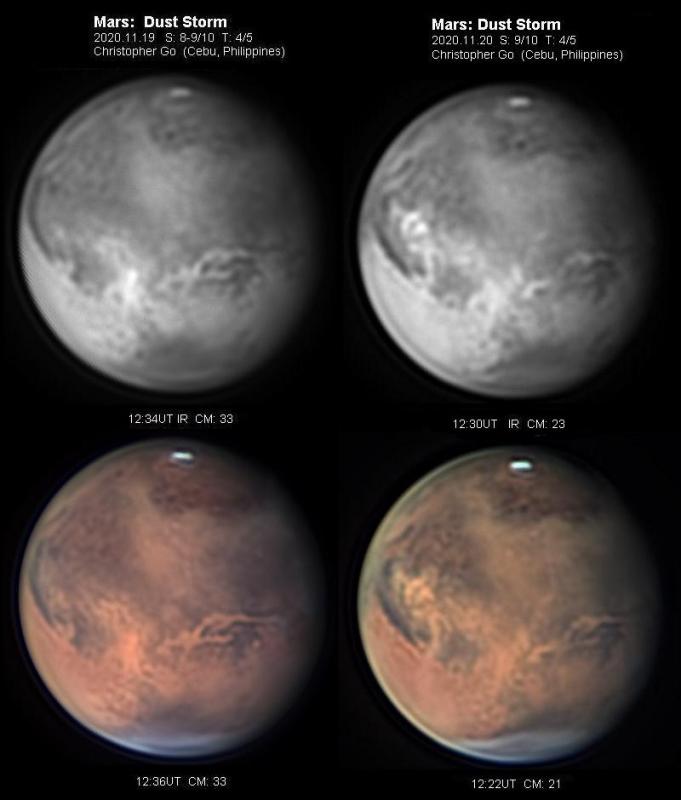
At the top of this page I am posting an updated list of (126) observers, locations and telescopes.
There have been many fine images taken of the unaffected hemisphere, and one of the very finest is surely the one of Nov 9 by Damian Peach in collaboration with Rico Enzmann (taken with a 1m remote telescope). Damian points out that it is even possible to spot the location of Gale crater as a curved indentation at the end of the left-hand projection of Sinus Gomer! I have posted it here at full resolution.
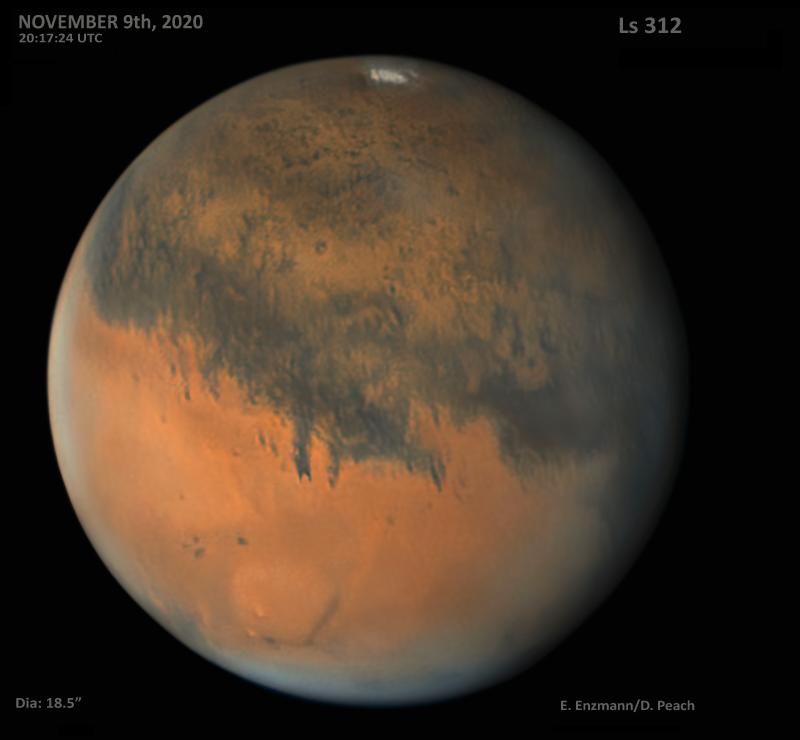
November 20: Regional storm update
Nov 18:
As promised yesterday, I am including images for the 18th with some for the 19th, to be described below. One by N.Haigh (UK) shows the W. end of the storm, with the eastern end and central portions displayed by T.Kumamori (Japan).
Nov 19:
A number of UK and European observers saw the storm well, though the seeing was not very good for some UK contributors. The Director’s view (with the western edge of the storm just following the CM) showed no further progression to the west. A small dust cloud is still located over Solis Lacus. There is a bright dust disturbance between Meridiani Sinus and Margaritifer Sinus, while Margaritifer, Mare Erythraeum, Argyre and western Noachis are mostly hidden by existing dust. Suspended dust remains in Valles Marineris. To the southeast, dust activity still stretches as far as Hellespontus. The east part of Noachis and most of Hellespontus are still unaffected, as are the SPC and NPH.
We show an actual and a ‘difference image’ by C.Fattinnanzi (Italy), showing the western end, and an image by P.W.Maxson (USA) to illustrate the unaffected hemisphere.
If you are reading this blog as a non-BAA member, you can still send the Association your Mars images by emailing me at richardmckim-at-btinternet.com, but please make clear your telescopic equipment and observing location either upon the image or in an email.
November 19
The number of active observers now stands at 126, and we shall update the list shortly.
Nov 18: Useful observations of the western end of the Regional dust storm were made from the UK by P.G.Abel, M.Foulkes, N.Haigh, R.J.McKim and C.Nuttall; images were also obtained by C.Fattinnani and M.Bianchi (Italy), A.Cidadao (Portugal), C.Foster (S. Africa) and M.Kardasis (Greece). An irregular belt of creamy-yellow dust (with several brighter condensations) stretched diagonally from Argyre across Bosporus/Phrixi Regio, reaching as far west as Aonius Sinus, and obscuring part of central and southern Solis Lacus. The storm does not appear to have progressed significantly beyond its previous western limits. Observations from several observers in Australia and Japan nicely documented the activity of the eastern and central parts, and a number of spectacular images are to hand. Dust is heading east at high latitude, as far as southern Hellespontus, though there has been no eastward progression at the latitude of the northern part of Noachis. Activity remains within Valles Marineris, and Margartifer Sinus is now somewhat affected, but the dust over Sinus Meridiani reported yesterday has apparently dispersed. The SPC remains sharp, and the NPH is still visible.
Fattinnanzi made a ‘difference image’ with his own of October 18 at the same CML, which clearly shows the difference made by the storm. This is posted at the website of ALPO Japan.
Nov 19: I was able to see the storm around Solis Lacus this evening around 1700UT. The appearance of this part of the storm was similar to yesterday. Other observations for today are arriving as I post this update around 2100UT.
I hope to have time to post images for Nov 18 and 19, and further details for Nov 19, tomorrow.
November 18: The regional dust storm
Nov 16: To add to the illustrations posted yesterday, we add an image and two different map projections by Kardasis to show how the storm region then appeared on the evening side of the disk.

Nov 17: Many images have come to hand. J-J.Poupeau in France, and C.Nuttall and M.Phillips in the UK, just caught the storm on the evening side. Skies across the UK were mostly overcast. C.Foster (S.Africa) got a good image to show the fresh developments around Solis Lacus, and observers in the Philippines, Japan and Australia produced valuable results. Observers in the USA showed that the Hellas basin remained inactive and that the morning clouds and NPH were normal. We give a collage of the work of M.Lonsdale, C.Go and Foster: the affected area (stretching over more than 100 degrees in longitude) is now greater than can be followed by a single observer. Dust has spread over western Noachis and Argyre; activity is beginning over Sinus Meridiani; bright nuclei are seen at and SW of Solis Lacus; Valles Marineris remains bright and dusty, and further north there is some activity over Chryse.

This storm is closely following the pattern of previous such events. Dust may reach Hellas and even Isidis/Libya (as it did for example in 2003), but would not be anticipated to travel further east, while we would not expect the dust currently SW of Solis Lacus to progress much further west. In other words at this late stage of the martian year it is highly unlikely to become an encircling event.
November 17: The Regional storm
Nov 15 (additional): Today I am posting drawings of the event by M.Adachi (Japan) and images by T.Kumamori (Japan) in a small collage. The images by Kumamori confirm how the Valles Marineris dust had become fainter in the smaller linear portion just east of Aurorae Sinus compared with the 14th, though the large expanse just south of there along the valley was undiminished in brightness. (See the impression reported by Go in yesterday’s post.)
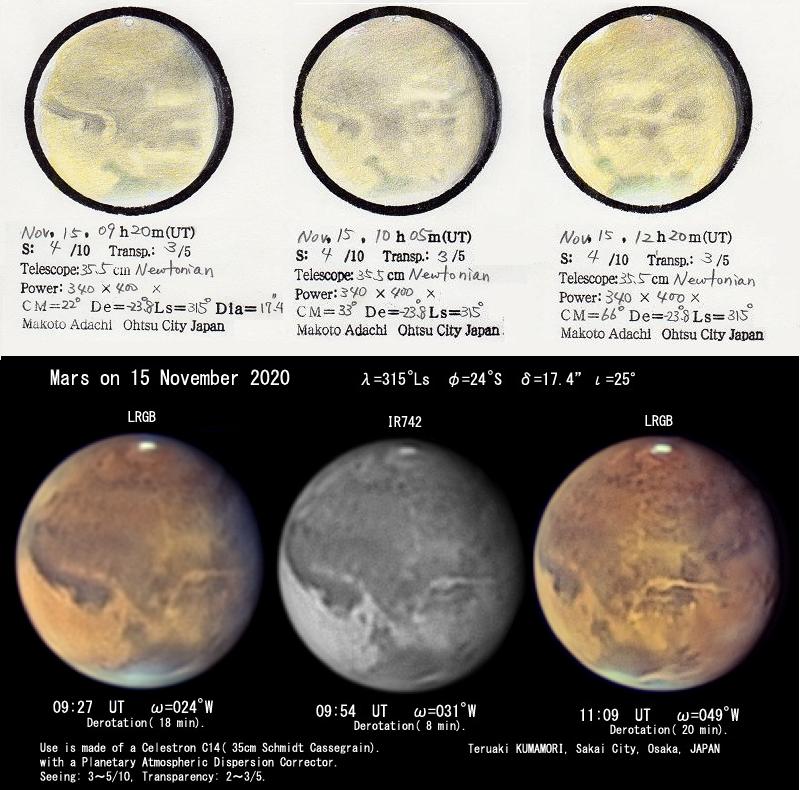
Nov 16 (new): Images by many observers now showed the storm having expanded from Mare Erythraeum westward across Bosporos Gemmatus (in Ebisawa’s nomenclature) into the desert around (and also partly covering) Solis Lacus. Some dust has reached Argyre to the south. There remain active regions in Chryse, Juventae Fons and Ganges. Bright suspended dust remains within the Valles Marineris. Clouds prevailed at the Director’s observatory tonight, but from Greece M.Kardasis was able to image most of the storm towards at the evening limb. This time we offer a collage by K.Yunoki (Japan) showing the storm at nearly the same CML from the 12th to the 16th to more easily illustrate the daily changes: the fading of the dust east of Aurorae Sinus on the 15th is clear, but on the 16th that region was again bright! We also show a nice IR image by D.Milika & P.Nicholas (Australia).
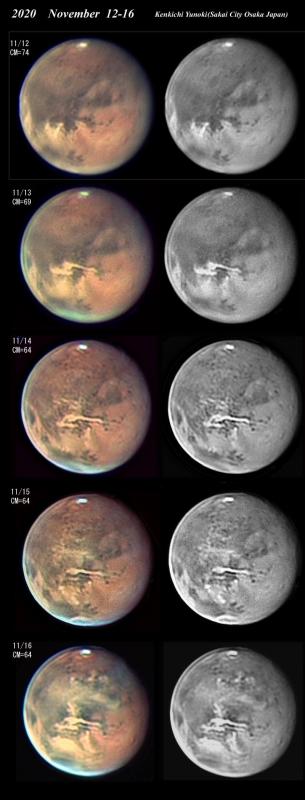
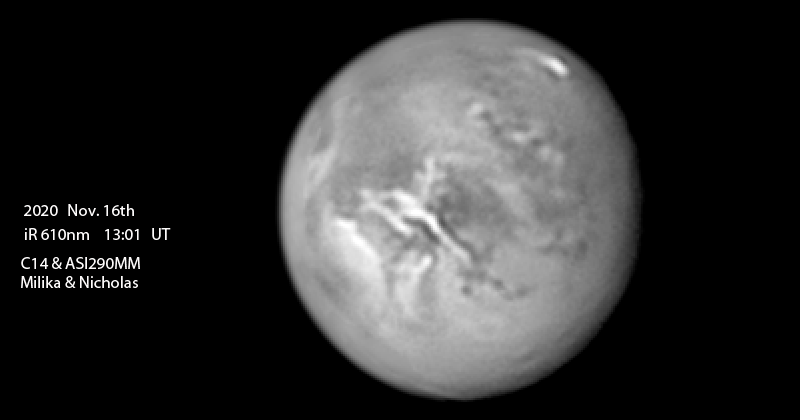
November 16: Regional storm update
Nov 15:
Our Far East and Australian friends again have had the best views, and Chris Go’s image of 11.39UT is shown here for comparison with the 2005 October event by Randy Tatum. (Our BAA report on the 2005 storm is to be found in part 1 of the Section report, available in the download area.) Compared to the 14th, some further expansion of the Mare Erythraeum cloud has occurred, with a finger of dust stretching to eastern Argyre. Further small, bright, dust cores have appeared in southern Chryse, but on the other hand the bright dust suspended within that part of the Valles Marineris canyon system immediately east of Aurorae Sinus looks considerably fainter.
The Director caught the planet with a 75 mm OG at 16.55UT and could see the storm as a bright yellowish cloud upon the p. limb, but he made a better sketch with his 410 mm Dall-Kirkham Cassegrain from 17.15UT. Already with the shrinking disk he preferred to use a power of x331 compared to his normal one of x265. There were several very bright yellow limb clouds corresponding to those in Go’s image, one preceding Solis Lacus, stretching from the latitude of southern Chryse to the south of Mare Erythraeum. Further bright yellowish areas were seen still further south and in the north. These all had diffuse edges. The NPH was rather thin at this CM longitude (138 degrees at 17.15UT). Clyde Foster on the previous two evenings had also caught the storm right upon the limb, so that it made the limb band bright and yellowish.
Nov 16:
I have not yet seen any images from today’s presentation of the region, but a few things to watch out for…. It is usual for the limb to be tinted yellow at the latitude and longitude of the storm, and for a reduction in white cloud activity nearby. We might expect further dust cores to develop. The NPH might recede.
Later I will try to post some collages to show how different longitudes have changed with time during the apparition. Meanwhile I add a small collage of pre-storm images by Araujo, Bullen and Storey. The latter’s work shows the region later affected by the storm.
I congratulate Makoto Adachi upon obtaining around 340 drawings to date, and to Kumamori, Maxson and Yunoki in taking over 400 images each. The highest number of images was attained by T.Arakawa (around 540). We have well over 8,000 observations archived so far, though there is some way to go to beat the previous record for 2003. Well done to everybody!
November 15: The Chryse-Valles Marineris dust storm
This event, now classed as Regional, continues to expand.
Nov 14: The suspended dust nicely picks out the complex canyon system of Valles Marineris, and remains bright. Since Nov 13 the dust activity has expanded over Ganges and to the south into Mare Erythraeum. There is also dust at Juventae Fons, just where it had occurred on a one-day basis on Nov 5.
Other items:
Paul Abel has made a detailed and labelled map from his own near-opposition observations. We are pleased to post it here.
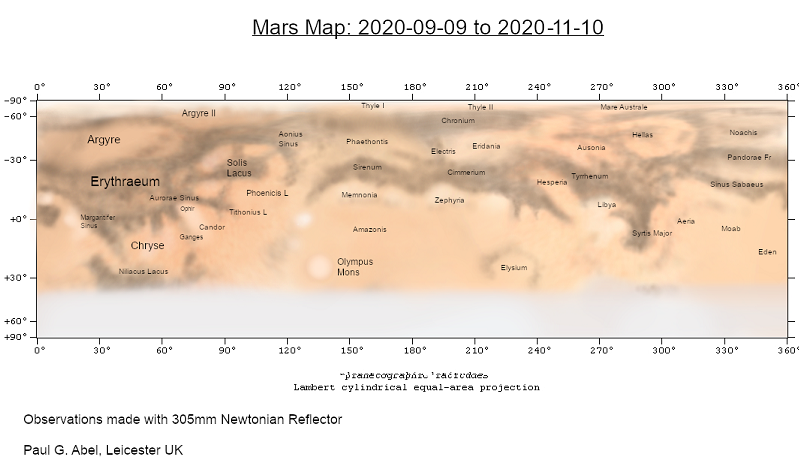
November 14: An update on the Chryse-Valles Marineris dust storm
Nov 11: Images of the storm region at 11.45-1217UT by K.Yunoki (and not available at the time of the alert on Nov 12) show a small yellowish patch in Chryse Planitia near the evening limb, much brighter in red than in blue light. This therefore marked the start of the event. I examined other images of Nov 11 and found a faint trace of this local dust cloud upon T.Kumamori’s LRGB image of 11.23UT, but it was absent upon his IR images of 09.34UT.
Nov 12: Some more very nice images of the storm by more Japanese observers have been posted at online image databases since my last update.
Nov 13: The dust has expanded along Valles Marineris according to images by C.Go (Phillipines), N.MacNeill (Australia), and many observers in Japan such as T.Arakawa and T.Akutsu: see the collage, which shows the storm’s constant shape over several hours.
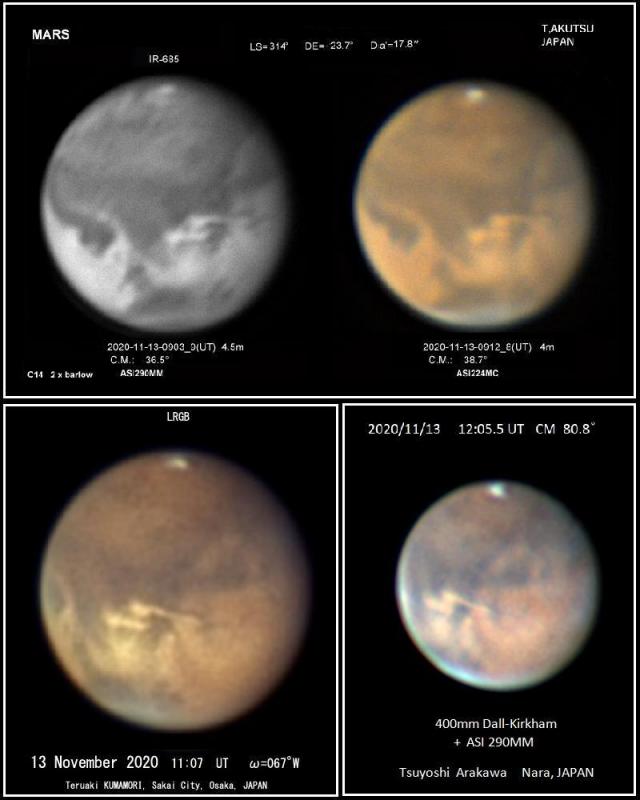
Nov 14: Images are just starting to come in, so I will write more about them next time. Observations by Go and MacNeill just received show that the storm has expanded into Ganges and southward into Mare Erythraeum.
On Nov 12 (Ls = 313 degrees, in southern midsummer) around 10.00 hours UT Makoto Adachi (Japan) observed a large, bright yellow cloud in southern Chryse, which was then close to the CM. He quickly reported the observation quickly by email. A few hours earlier, I had seen a single colour image by Ethan and George Chappel (USA) posted at the PVOL website, which showed the same feature, and which bordered Valles Marineris. Although this looked like fresh dust storm activity it was too close to the morning terminator to be certain. But following Adachi’s email I posted an alert upon this website’s front page, on the evening of Nov 12.
Today I have received images directly from Chris Go (Phillipines), and have downloaded images posted by Robert Heffner (Japan) and Teruaki Kumamori (Japan). Kumamori’s filter results showed the dust appeared brighter in longer wavebands, and it is clear the location of the event resembles the start of several previous such ones. Part of Valles Marineris is clearly involved in the dust activity. See the collage posted here. So the activity was kept in view from the morning to the evening side over a period of some six hours, during which time the dust clouds showed no obvious change in form.
If the storm develops further, which is likely, it may follow the pattern of previous years and grow into a large regional event, and we add a collage of the events seen in 2003 (which also began at Ls = 313) and a little of my previously published text for comparison. The BAA report on 2003 part 1 contains a full discussion of this storm, and may be downloaded from this website. The 2005 opposition also exhibited a large storm that began here, and other examples could be given. UK observers will have to wait almost a week in order to see the storm on the evening side.
I am posting this update before looking at images from today.
November 10
We have reached and passed the critical seasonal marker of Ls = 311 degrees with no encicling dust storm having commenced. Here is a collage of recent UK observations showing Hellas and environs:
R.N.B.Lewis (image on Nov 3), C.Nuttall (drawing on Nov 5) and P.G.Abel (drawing on Nov 6): The location of the lighter part of Hellas is typical.

And we add a drawing by Steve Gale (USA) and an image by P.W.Maxson (USA) to show the Sinus Meridiani – Mare Acidalium and Acidalium – Solis Lacus longitudes. Note the NPH is more evident on the Acidalium – Solis L. side.
Cristian Fattinnanzi (Italy, 360 mm Newtonian) has just made an excellent map from his near-opposition images, and I have manipulated his original to place south uppermost and longitude zero in the middle. Here it is:
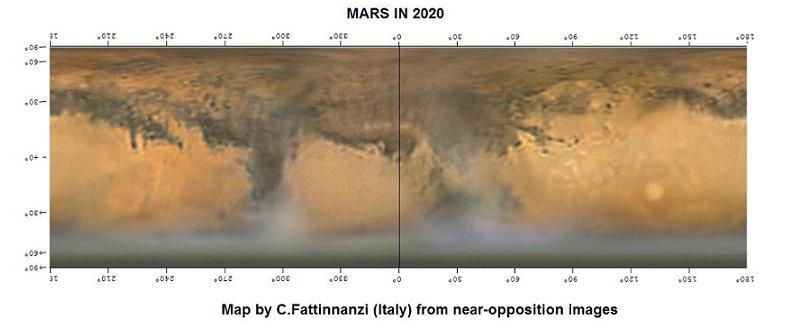
November 7 (Ls = 310 degrees) A One-Day Dust Storm
This update is just to post a few images to show the dust activity at Juventae Fons…. which turned out to be a one-day local event. The images shown here, taken by E. & G.Chappel (355 mm SCT, USA) for Nov 4, 5 and 6 are excellent. Other observers in the USA included G.Walker, F.J.Melillo and W.D.Flanagan. I have seen further really excellent images online from observers who are not part of the BAA network. (But if any of them are reading this, we would be delighted to receive your work too!) There was also some local dust around Nilokeras around Nov 5, at a location where there have been earlier, weaker, signs of dust on a few dates in late October.
Some small actual or suspected terminator projections at southern mid-latitudes have been reported in the past few days, including P.Edwards and the Director on Nov 5. Another appears on the Nov 5 image posted here. As always it is hard to be sure about them from highly processed images, as the terminator recedes with processing. Any objective projection ought to be visible upon the monitor screen in real time or at the eyepiece! All the recent instances have been associated with white cloud.
There is currently an excellent opportunity at the longitude of the UK to watch the interaction between the morning white clouds and the Syrtis Major and the Hellas basin. This has resulted in some fascinating observations for me personally over the last few evenings.
November 4 (Ls = 308 degrees)
I thought it would be interesting to look back upon the area of Oxia Palus and the Indus ‘canal’ from my own visual observations. So here are some of my drawings taken at the perihelic oppositions of 1988, 2003 and 2020: (A) 830 mm OG, x400 (Grande Lunette, Meudon Observatory, seeing fair only), 1988 October 26, CML = 350 deg., (B) 410 mm DK Cass., x410 (seeing very good), 2003 August 20, CML = 023 deg., (C) 410 mm DK Cass., x410 (seeing very good), 2020 October 22, CML = 028 deg. Apart from seasonal differences in the SPC and NPH, note how Oxia Palus is larger in 2003 than in 1988, and how the ‘canal’ (Indus) between it and Mare Acidalium had become enormously darker in 2020 (the latter change having occurred after the global dust storm in 2018). This is not the first time Indus has appeared dark. Look at many of the Mars drawings during long stretches of the 19th century, which give evidence of how the area has been involved with dust excavation on and off, even if we did not witness the actual dust storm activity at the time.
We continue to receive many splendid images from around the world. Here is one by W.D.Flanagan (USA) for Nov 1. At the N. end of the terminator there is a small, unusually dark patch with a white cloud nearby. This may be a minor example of what we have in the past called a ‘violet hole’, where there is a locally reduced concentration of atmospheric water vapour. In the colour image this is found to correspond with a small reddish patch, something the late M.Minami (CMO, Japan) used to call a ‘wine-red patch’. Towards the SPC there is an interesting fingernail-shaped white cloud that appears to project beyond the terminator. While the disk is still large it is a good time to look for such features.
2020 November 1 (Ls = 307 degrees)
I have added a reference albedo map at the top of the page, drawn by me for the 1990 opposition.
With the recent strong resurgence of the COVID pandemic, it is presently rather difficult to go abroad to find a better observing location, but in France there exist several handy high altitude observatories. C.E.Pellier recently travelled from Paris to the Hautes-Alpes to visit the Saint-Véran (or AstroQueyras) Observatory to secure some superb UV images with its 620 mm Cassgrain on Oct 17 and 18. Orographics are present over all the Tharsis Montes, with a very small white cloud over part of Olympus Mons. Few observers use a UV filter.
Of course, one does not have to leave home to use a large instrument these days, and as in 2018, Damian Peach has been obtaining some excellent images with a remote telescope in Chile, which can be viewed at his website. I am not posting the whole of his recent Oct 27 image here because we are limited at this website to an image width of 800 pixels, but I am showing the SPC area enlarged. Notice that the rift which had begun to indent the cap some months ago in the longitude of Solis Lacus now completely crosses it. This is unusual to see, as most previous images at this season have suggested that the rift did not reach the other side. Foster’s image of the same date also seems to show the cap split in half, though at a less favourable CML. The history of this rift needs further investigation.
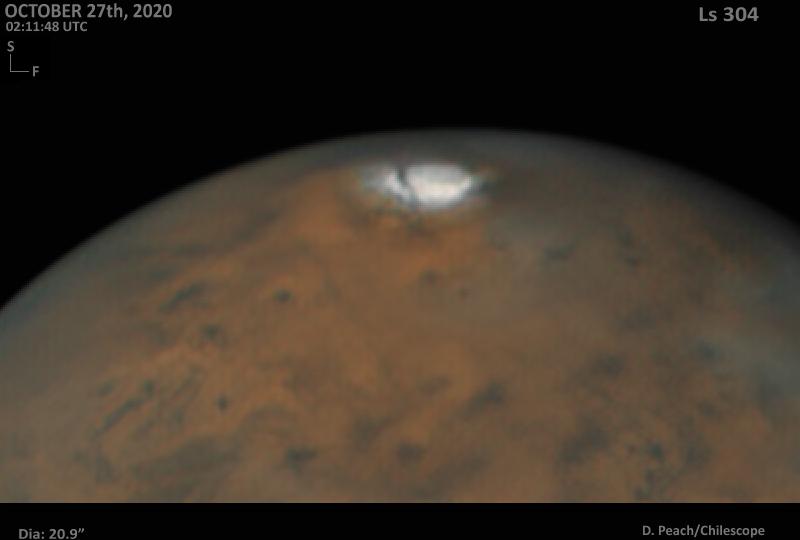
C.Foster’s image of Oct 27 shows the usual aspect of the Sinus Sabaeus area. Note how some features near the morning limb are blotted out by white clouds. The Director had a very similar view on Oct 27 and 28, after which the UK weather became unfavourable.
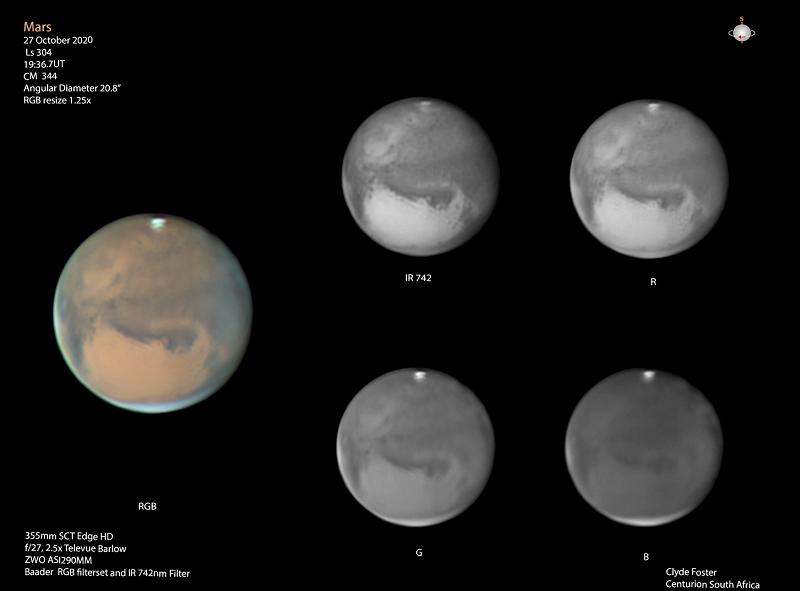
Images by K.Yunoki on Oct 30, 1209-1235 UT, CML = 208-215 degrees, show a fingernail-shaded terminator projection south of Hellas; its f. end was just visible to R.Heffner at 1449 UT, CML = 247 degrees. A UV image of Yunoki’s shows a bright cloud there, suggesting the projection was not dust-related. Images by two other observers from Japan posted at the ALPO Japan website confirm its continuing existence at 1315 and 1325 UT.
Observers should watch the NPH in the longitudes of Utopia and Mare Acidalium-Chryse-Xanthe closely for any signs of new dust activity, and also the Hellas basin to E. Noachis and the Solis Lacus region generally. Hellas and Utopia are now well-placed for UK observers.
October 2020
Generally unsettled weather has continued in the UK. Observing on October 15, the Director next had observing opportunities on Oct 20, 22, 23, 24, 25, 26, 27 and 28, but the seeing deteriorated as the early part of the evening progressed. The planet’s declination is currently +5 degrees, which is as least democratic in favouring neither N. or S. hemisphere observers.
The SPC is at a seasonal minimum, as this polar projection of Oct 17 by J.Sussenbach shows. Note the prominent rift.
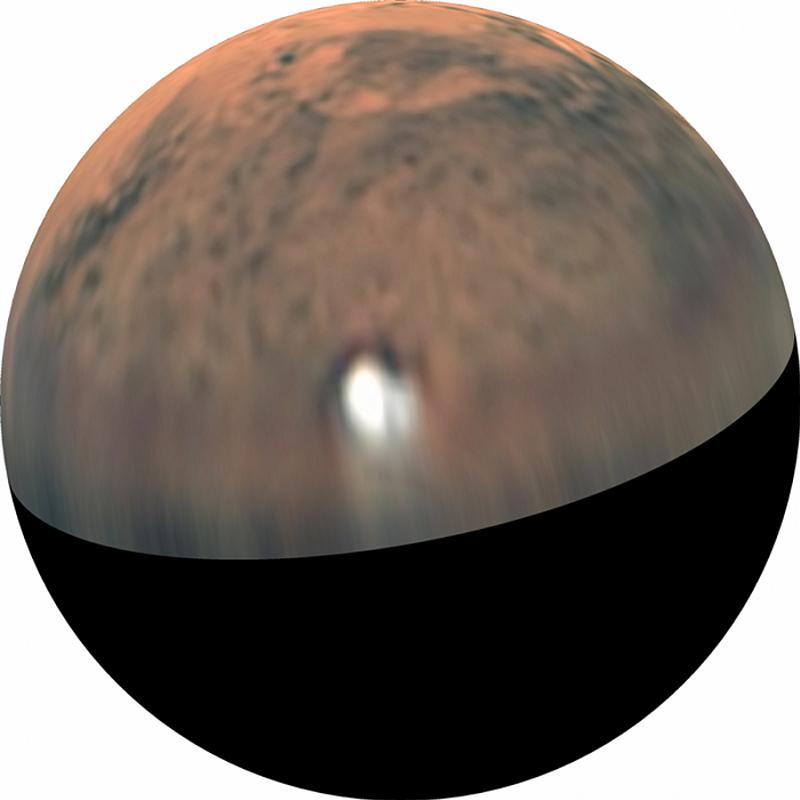
The morning terminator is now better presented, and the diurnal white clouds there have become more clearly visible. The contour of the terminator appeared slightly deformed in one place at mid-southern latitudes to R.Tatum and F.J.Melillo (USA) on Oct 24 and 25 respectively, due to the presence of protruding higher altitude clouds under CML 120 and 141 degrees.
One unusual phenomenon was shown in several October images, with attention being directed towards it on Oct 22 by a Romanian observer at the ALPO Japan website. This was a temporarily visible long dark E-W streak that trailed Arsia Mons as the latter moved onto the disk, vanishing later in the (local) morning. V.della Vecchi (Italy) was also able to record the streak on Oct 22, and to inform the Director. Arsia and the other Montes were also surrounded by morning white cloud. It seems that the cloud following Arsia – not the volcano – was casting a long shadow. The effect can be seen in some images from Oct 12 onwards but the visibility period during the martian morning is limited. Too near the terminator, and the whole area is hidden by extensive surrounding cloud and any shadow too short. But too far into the morning, the cloud – and therefore the shadow – has vanished. The news was picked up and reposted at the Spaceweather website on Oct 24, while on Oct 28 R.Konnai and M.Murakami at the CMO Mars Section website posted a very good map projection of an image on Oct 12 by R.Heffner (Japan) to demonstrate and comment upon the shadow effect. (They comment that spacrecraft data have shown this to be a recurrent seasonal effect which may be observed between about Ls 230 and 305 degrees.) Earlier in the opposition (see Part 1 of this blog) we had some evidence of an evening shadow at Arsia Mons. Here we show della Vecchia’s image with the streak indicated. A proper search of the database has yet to be conducted.

The north polar hood is wider in the north-south sense, and most variable in the longitude of Mare Acidalium, while the ‘canal’ between Oxia Palus and NE Mare Acidalium is still wide, dark and prominent.
Hellas and Argyre in the south have been no brighter than the equatorial deserts, and the long interval since the last major dust storm activity has helped any local winds to blow any settled dust off exposed bedrock, so darkening more of their basin floors. A significant part of E. and SE Hellas is quite dusky, as shown in the Oct 21 image by T.Barry, with the region of the ‘canal’ Peneus visible, and a large central area that includes the classical dark patch Zea Lacus. Argyre is not well-defined, and some rarely visible interior albedo details can currently be seen in its vicinity. Yaonis Fretum is visible on the W. side of Hellas but is often darker than currently; Hellespontus is also not very dark.
Today Ls equals 305 degrees, and so we shall soon reach the important threshold of Ls = 311, which is, at stated previously, the expected ‘last chance’ for any encircling dust storm to begin.
The efforts of our 116 observers are much appreciated. A fresh detailed list has been uploaded as a Word document above, and I would encourage everyone to check their entry and to let me know any mistakes.
October 19
A revised list of 112 contributors is given above.
Silvia Kowollik (Germany) has made a map constructed from her own images taken near opposition, and we post it here.
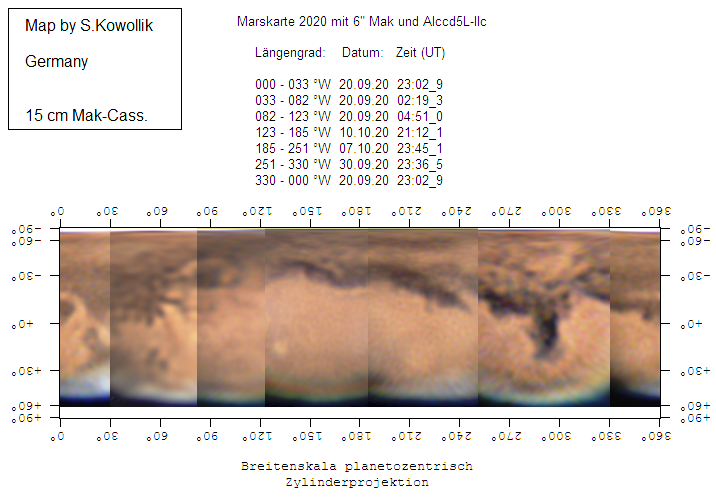
Several members have succeeded in seeing or imaging the moons. Here is a nice composite image by M.Radice (UK) taken on Oct 14, and for once we will allow north to appear at the top.

The fine image by Daniele Gasparri (Italy) on Oct 10 shows a small afternoon cloud upon the south flank of Olympus Mons, with evening clouds forming over each of the Tharsis Montes.
Some observations from the longitude of the Far East are showing the so-called ‘Dawes slit’ phenomenon, where the north polar hood covering Mare Acidalium becomes partly transparent, so letting a belt of dark ground show through. This effect was first observed by W.R.Dawes in 1864. See the drawing by M.Adachi (Japan) posted here. Note also that the increasing activity of the hood may give rise to dust storms in the vicinity, and that these are particularly likely to take place (if indeed they do) in the longitudes of Acidalium and/or Utopia.
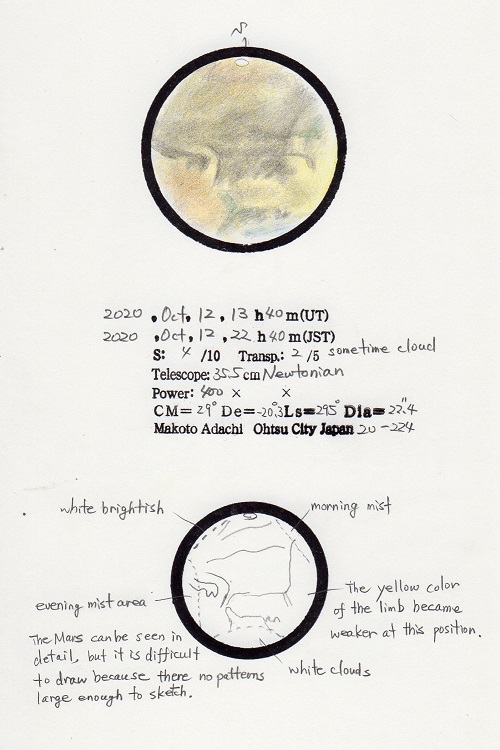
Since the last post, generally cloudy weather has continued over much of the UK: my last clear night was a brief gap on the evening of Oct 15.
October 16
We have 109 active observers now, and I will update the list posted above shortly. The night of opposition on Oct 13-14 was cloudy for many UK observers, including the Director. But the evening of Oct 12 had been clear, and we had many observations sent in by some of our overseas contributors. October 14 and 15 offered clear spells for some UK members.
D.Tyler (UK) on Oct 9 shows a hint of cloud at Olympus Mons in the evening (visible upon the Oct 9 image), but near the CM it just appeared slightly light. Hecates Tholus and Elysium Mons appear as light, ground-lit patches. Notice the prominence of extensive Libya-Isidis Regio evening cloud p. the Syrtis Major in the images by G.Walker (USA) on Oct 8. The NPH extends to lower latitude in the longitude of Mare Acidalium, as imaged by A.Casely (Australia) on Oct 10, while on Oct14 M.Phillips (Scotland) showed an asymmetric patch of hood at Arcadia, on the f. side of Acidalium.
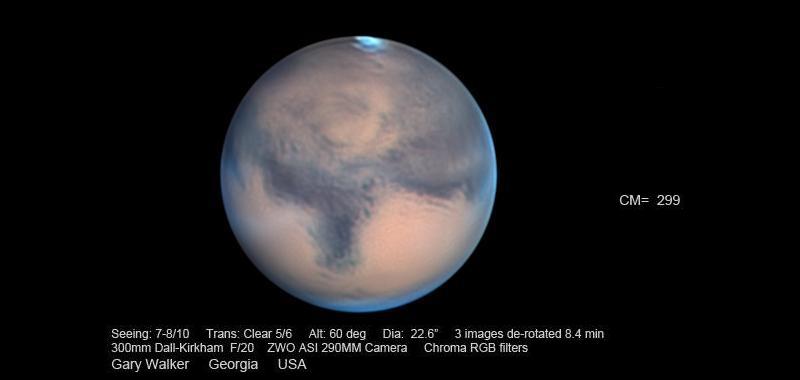
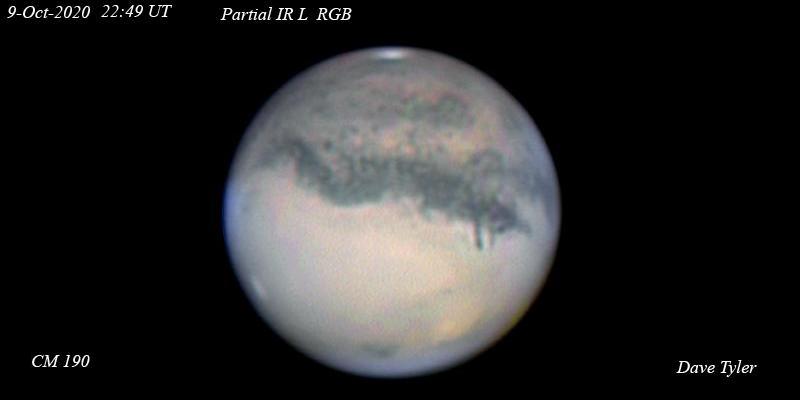
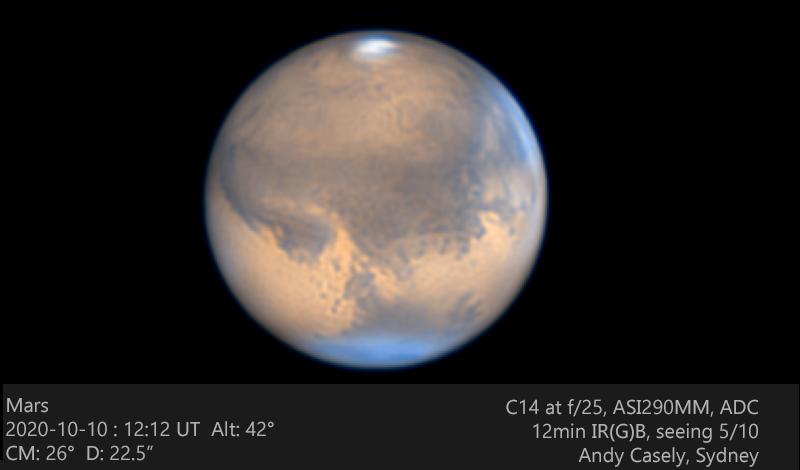
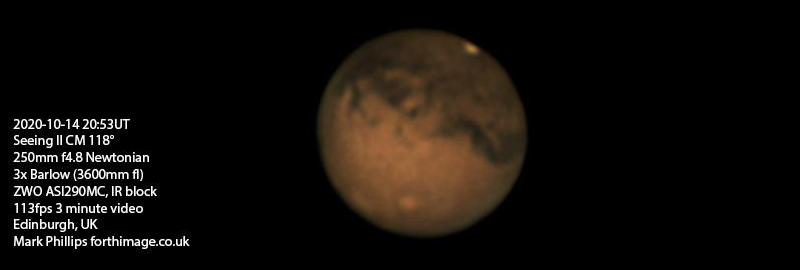
Everywhere the surface features have remained clear and sharp for the opposition period. Ls has now reached 298 degrees. From the record book the seasonally latest encircling dust storm was observed to have commenced at Ls = 311 (1924 December 9), so we shall soon know whether or not 2020 may produce such an event.
October 12
Opposition is very nearly here. The main inconvenience of COVID-19 astronomically has been to prevent several members in travelling to more favourable locations to observe. But nevertheless we currently have 101 active observers who supplied useful work, with the names of A.W.Heath, A.Clitherow, R.W.Johnson, D.Strange, M.Phillips, P.Tickner, W.P.Sheehan, T.Barry, R.Bullen, R.Lewis, P.Lyon, D.Storey and M.Araujo to be added to our earlier 88-strong list.
Weather and seeing conditions across the UK have not been of the best during the past week, but a significant number of BAA members were able to get decent results on the night of closest approach and since.
October 6: Mars at its closest by S.Ito (Japan) and M.R.Lewis (UK), respectively. Note the increased level of diurnal cloud in blue light, and the fairly bright (ground-lit) Olympus Mons on the morning side. Comparing his own images of Oct 8 and 9, D.Gasparri (Italy) considers that there was also a small evening cloud at Olympus on Oct 9.
October 7: E.Grafton (USA) shows the return of diurnal (evening) cloud over Libya-Isidis Regio.
October 8: P.Tickner (355 mm SCT, UK) sent a video (21.46-23.16UT) showing the swift motions of Phobos and Deimos. (Note that this video is flipped in the E-W sense.) Several other members have reported imaging the moons.
October 9: A hi-res view by J.Sussenbach (NL). The Director has several good sketches of this longitude at which there was far more detail visible than could be drawn. The small spots resolved include the little Caralis Fons (which I believe was not observed before 1926), south of central Mare Sirenum, which I could see visually.
I am posting six drawings obtained with my 410 mm Dall-Kirkham Cassegrain, x265 and x410, white light and with Wratten 21 orange and 44A blue filters. I made extensive colour notes, so one day I may redraw them in colour.
There is another Interim report published in the October number of the BAA Journal, just issued.
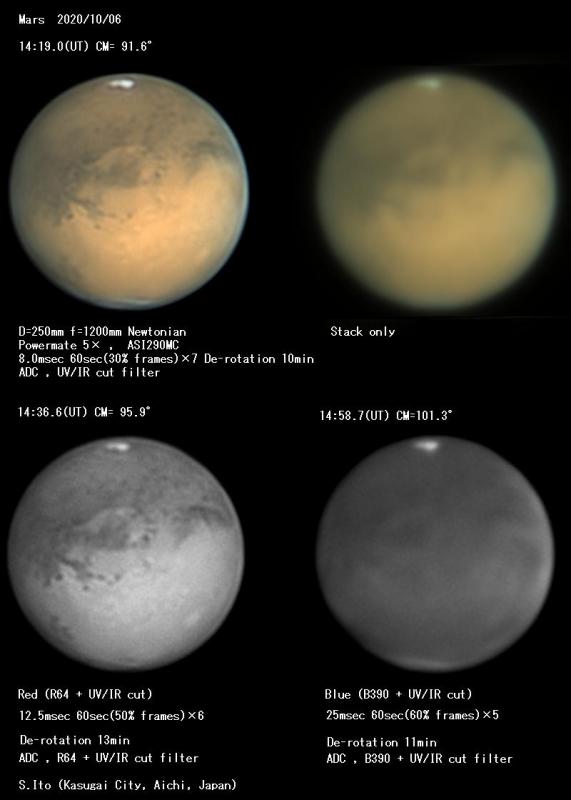
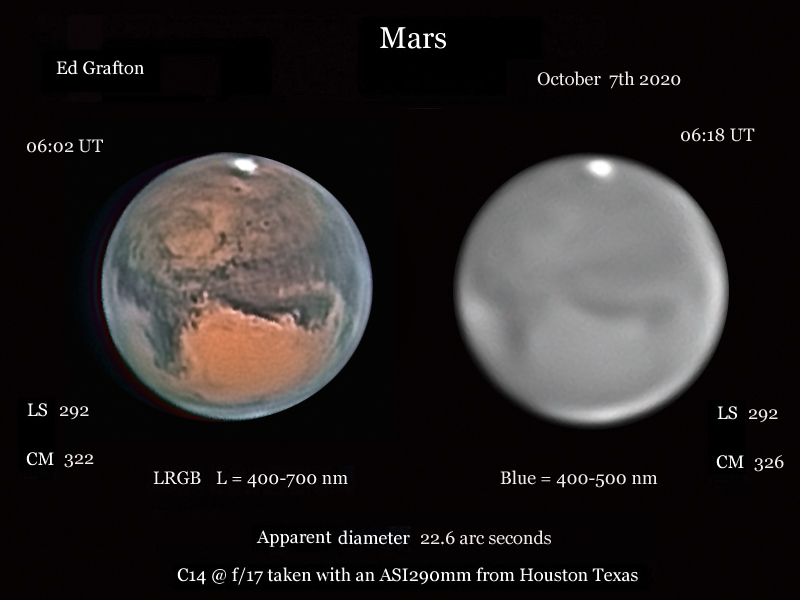
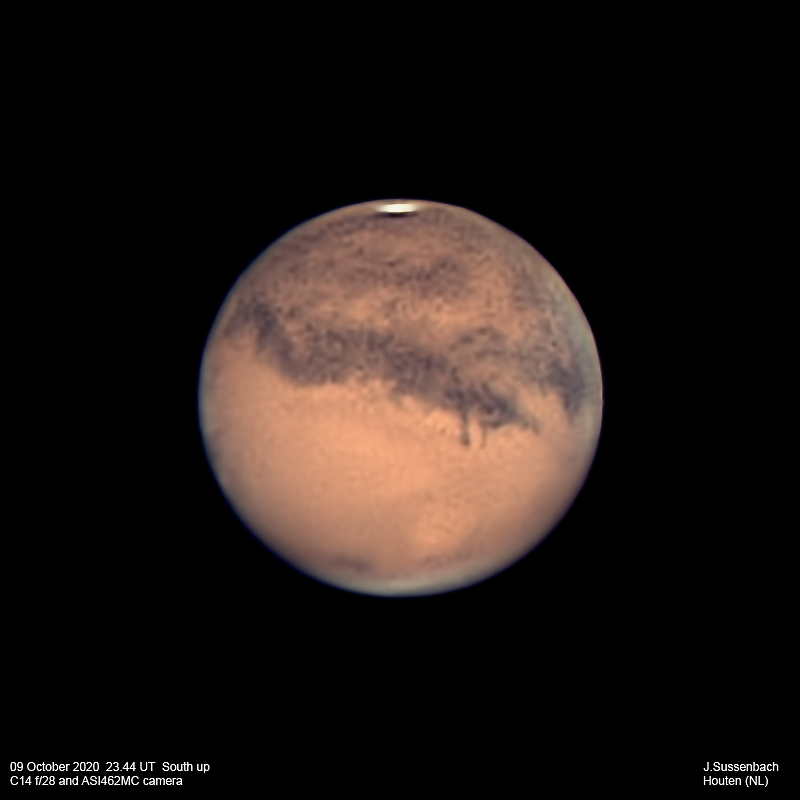
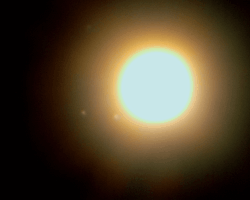
The date of closest approach is upon us, although opposition is still a week away. Here is a representative gallery of images from our 92 active contributors, including some of the highest resolution work, from around the world. All were obtained in late September or early October and I am posting them in order of increasing CM longitude, together with a collage (on the front page) in which I have adjusted the images roughly to the same scale.
Notice the continuing orographic clouds in Tharsis, the fine details upon the surface everywhere, the continuing faintness of the surroundings of Elysium, the persistence of several albedo changes resulting from the 2018 global dust storm, and the brighteneing of the slopes of Olympus Mons: an opposition effect. Likewise the locations of the much tinier Elysium Mons and Hecates Tholus show up within Elysium upon the images posted here, taken by C.Go and T.Kumamori.
The UK weather, which had been cooperating nicely a few weeks ago is now in the process of letting us down with cloud and rain. Make the most of every opportunity!
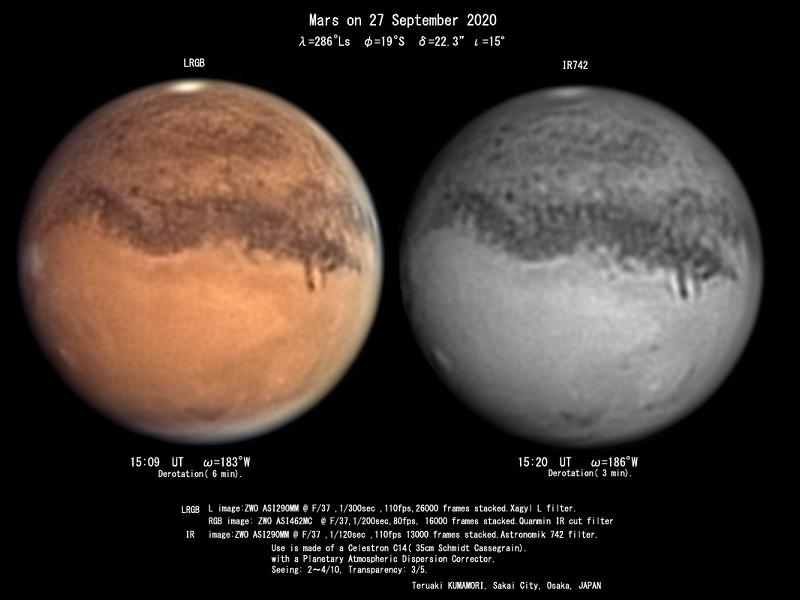


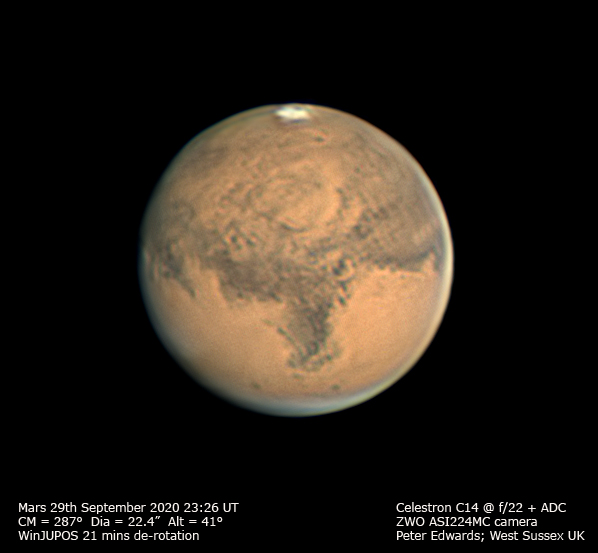
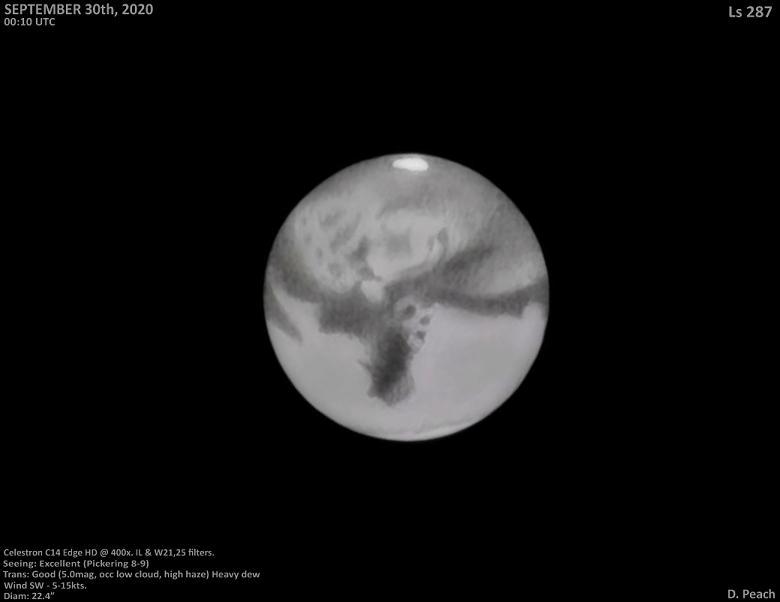
A small gallery, showcasing recent visual work. The Director will post some of his own sketches later. Good observing!
Chris Nuttall:


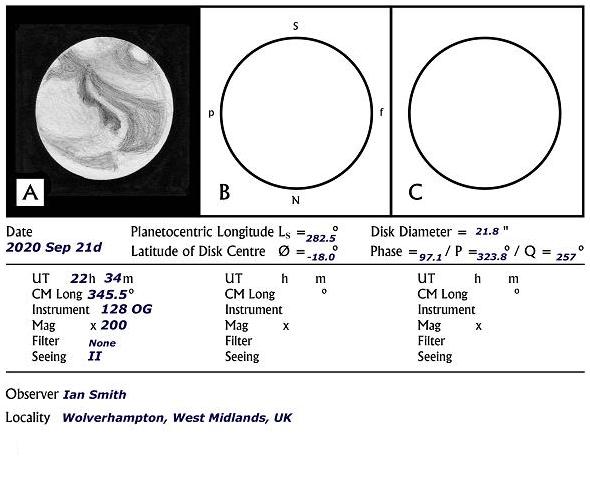


Several other observers have sent in their data, taking the number of active contributors to 91. Over the past few weeks the persistent evening cloud over Arsia Mons has become more prominent. Recent images indicate that the diurnal cloud over the Tharsis Montes has spread to include Pavonis Mons. See the image by R.Konnai (Sep 28) here.
It is clear that the slopes of Olympus Mons have been brightening recently, but if one looks at the blue light images in comparison with the RGB composites, there is no further enhancement in blue light, unlike for the clouded Tharsis Montes, showing that its slopes are merely sunlit. A strong ‘opposition brightening’ of this and other volcanoes has been witnessed in certain apparitions, for example 2005, and this has nothing to do with the presence orographic clouds. The effect can be seen on Konnai’s images.
Another ground-lit volcano is Hecates Tholus, and it can just be made out in a superb recent IR image by A.Wesley (Sep 27) posted here, and in a RGB one by C.Go on Sep 25. The effect is best seen for a week or so either side of opposition.
The Director had some excellent visual views on the night of September 29/30. We hope to publish a selection of recent drawings soon.


September 2020
Mars will be closest to the Earth on October 6, and at opposition a week later. So today we are just one week before closest approach, and this time I am posting images recently obtained in the UK by David Basey (Sep 21, RGB), Simon Kidd (Sep 22, RGB), Prof. Bill Leatherbarrow (Sep 15, RGB), Geof Lewis (Sep 20, IRGB) and Martin Lewis (Sep 14, R). (I am posting just one collage today, as there has been some difficulty with uploading multiple images lately.) These results are notable for the clarity of the martian atmosphere, the large amount of detail resolved, and the further development of diurnal clouds and the N. polar hood. We are no longer seeing any small dust storms around the S. polar cap, and nothing major anywhere else. This situation of course can change suddenly.
With regards orientation of images, it will be useful if all of them can be submitted with true north at the bottom. The quantities P and Q in the BAA Handbook enable the image to be correctly oriented. P is the position angle (PA) of the planet’s axis of rotation in the sky, measured eastwards from true north in the sky. Q is the PA of the greatest defect of phase, measured in the same manner, and is of course of more interest to the visual observer preparing a drawing blank. WinJUPOS shows the situation in a graphic, so that it should be easy enough to orient the image correctly, although when there is no phase defect it is more difficult to do. Turning off the drive will show the direction of the true east-west line, of course, and if this is made precisely horizontal in the field, knowledge of the value of P alone will enable the exact orientation to be established later.
This is the third successive update promised on September 17. This month, observers have reported that the bluish N. polar hood has become more prominent. It is often asymmetric with regard to brightness and width. What about diurnal white clouds?
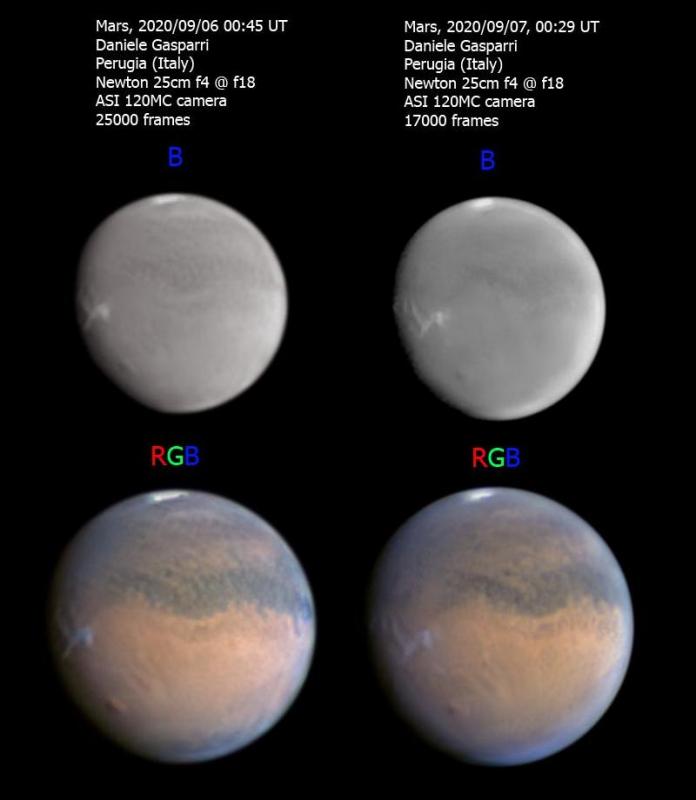
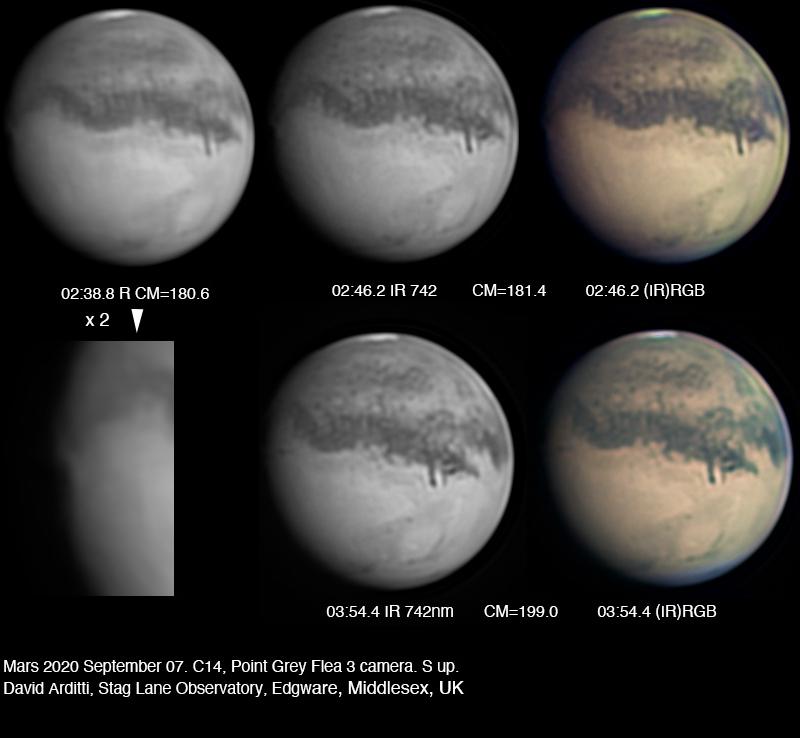
White clouds have also become more evident, and the images by Daniele Gasparri (Italy) shown here for September 6 and 7 show that the cloud at Arsia Mons appears on either side of the summit giving a sort of ‘butterfly’ effect, which was also particularly evident in 2005. See also the fine image by Damian Peach on September 12. Some sightings of other slight morning and evening clouds have been made, with the Director recently seeing a weak evening cloud at Chryse and some local enhancements in the morning limb brightening. And on September 16 Wesley imaged a large evening cloud over Isidis Regio and surroundings to the east, which formed a slightly brighter area in blue and violet light.

Terminator projections were occasionally reported. In particular, the inclined longitudinal streak of bright evening cloud at Arsia Mons sometimes appears to have projected beyond the terminator, and the effect was reported to the Section by Alexey Pozharov (Russian Federation) on August 30 around CML = 176 degrees, and more recently by David Arditti on September 7 around CML = 181 degrees, from areocentric longitude Ls = 268 degrees onwards. (Ls = 270 degrees marks the beginning of the martian southern summer.) Arditti tells me that the projection effect was apparent on the monitor screen as well as on the processed images posted here. And now from the USA, Martin Ratcliffe has reported the same effect again on September 14 (CML = 189 degrees), as that region had become well-placed from his longitude. I have posted his RGB composite image here. In Arditti’s image, also posted here, the presence of what appears to be a cloud shadow adjacent to the bright strip of cloud adds weight to the visual impression that the cloud projects beyond the terminator and even that the shadow is a surface depression. Observing on August 31, Pozharov saw the projecting cloud and also its shadow, using a 50 cm reflector at x216. He made a sequence of sketches (posted at the website of ALPO Japan) over a period of 37 minutes showing how the cloud first projected beyond the limb, and how the shadow then made an appearance. Eventually the phenomenon disappeared as the planet rotated. He repeated the observations on September 1 and 2/3, and although there were slight differences from night to night the sequence of events was essentially the same. Bill Flanagan and Ed Grafton (both Houston, Texas, USA) on September 16 also caught the shadow of the Arsia Mons cloud right at the terminator.
I had always been sceptical of seeing martian cloud shadows in Earth-based observation, given that the martian atmosphere always contains a certain amount of dust that greatly reduces the sharpness of such features under oblique lighting conditions at the terminator. But with the planet’s atmosphere being so clear of late – and for such an extended period with almost no telescopic dust activity evident – it is much easier to imagine that cloud shadows might be seen clearly enough when very close to the terminator. The phenomenon has not been limited to Arsia Mons. Peach on September 12 shows a projection under CM = 139-142 degrees, and it was most apparent in blue light, implying white cloud, located around the longitude of Aurorae Sinus. In his images of September 13 (CML = 115-135 degrees) there is good evidence for the same effect just east of Aurorae Sinus, and it is particularly apparent in the blue filter images posted here. The feature appears as a long strip of white cloud elongated N-S. Evening cloud at the same latitude was observed to reduce the intensity of Margaritifer Sinus near the terminator to the Director during his visual studies on September 12-14.
Years ago I was very surprised by some old drawings at the opposition of 1894 (August 24, Ls = 267 degrees) by W.H.Pickering in one of the later editions of Sir Robert Ball’s famous book, ‘Story of the Heavens’. They also appear in the yet more famous book ‘Mars’ by Percival Lowell. The sketches show both projections and apparent depressions at the evening terminator. The projections were surely due to clouds, and it is possible that the depressions were caused by cloud shadows with a particular orientation of the clouds. The longitudes do not correspond to the region of Arsia Mons. But it may be significant that these old observations were made at the same season, for 1894 is like the opposition of 1941 in resembling 2020 rather closely. 1894 was of course the first opposition studied from the then brand new Lowell Observatory, but for the BAA Mars Section it was our second!
It is also the case that the Arsia cloud is now visible earlier in the martian afternoon, as shown for instance in the images posted here by Chris Dole on September 14 and by Mark Radice on September 16. There have been recent reports too of a cloud at Pavonis Mons.
Opposition will soon be upon us. I have noticed a number of BAA observers have taken images and posted them upon their home pages but – surely for reasons of false modesty – have not communicated them to us. This is a pity, for unless they are sent to the Section those observers will not be included in our reports.
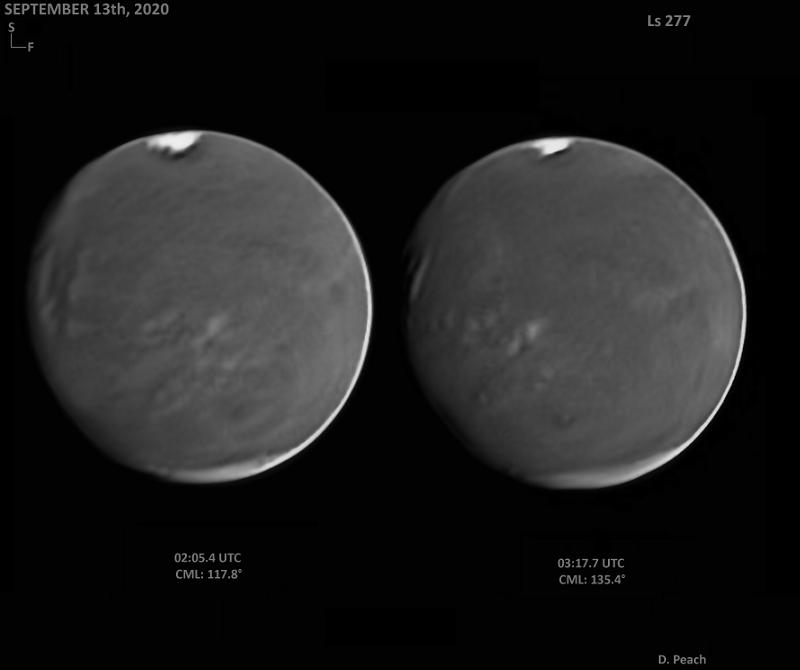
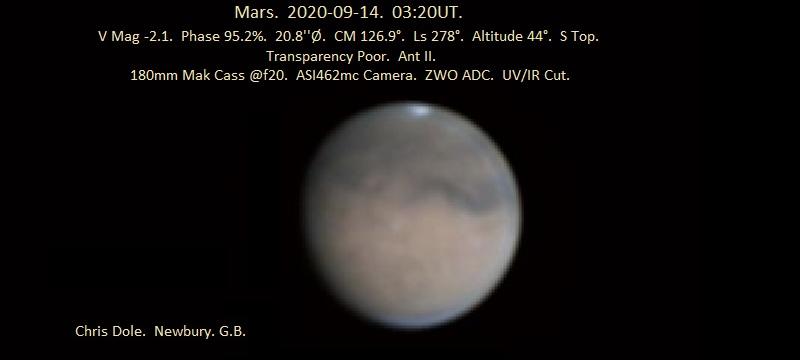

September 17
The images for this post from Part 1 could not be uploaded due to limitations on the page size, so they are added here. [ADDED LATER: I am sorry that not all of the images referred to have cooperated nicely with the Drupal operating system, and some just would not agree to be uploaded. After crashing the webpage several times I have for now given up for now….]


For earlier updates, see part 1 of the 2020 Mars Opposition Blog
| The British Astronomical Association supports amateur astronomers around the UK and the rest of the world. Find out more about the BAA or join us. |
